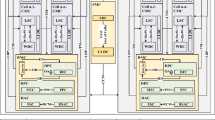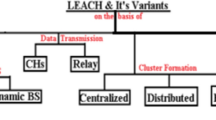Abstract
With the recent endeavour of smart city mission, it is being planned to install sophisticated infrastructure for providing various smart services. But the planning to handle unwanted events like disaster has not received much attention as part of this endeavour. In a post-disaster scenario, one of the most important services is to disseminate crucial situational information among different stakeholders when the traditional communication infrastructure becomes non-functional. The smart phone based delay tolerant network (DTN) shows its useful applicability in such a scenario. Further, it is well established that due to the movement pattern of the stakeholders with handheld device, it typically forms clusters based on their work areas. However, the existing DTN routing protocols are not designed for cluster architecture. This motivates us to propose a cluster routing considering a utility based optimal dropbox (DB) deployment that assists in providing improved network performance. In this paper, we primarily consider that DBs are deployed at strategic locations of the disaster affected area using an existing utility based dropbox deployment. Then we propose a mixed integer linear programming based optimization model, to enumerate the optimal number of dropboxes to be deployed at high utility locations. We finally propose a cluster based routing with a target to improve network performance. We evaluate the comparative performance of our proposed optimal DB deployment based cluster routing through both theoretical analysis and simulation. Exhaustive simulation is carried out in ONE simulator using real disaster data. Results show our scheme’s dominance over the competing schemes.















Similar content being viewed by others
Data availability
Not applicable.
References
Alazawi Z et al (2014) A smart disaster management system for future cities. In: Proc. ACM International Workshop on Wireless and Mobile Technologies for Smart Cities (WiMobCity), pp 1–10
Dinh D et al (2018) ICT enabling technologies for Smart Cities. In: Proc. IEEE 20th International Conference on Advanced Communication Technology (ICACT), pp 606–611. https://doi.org/10.23919/icact.2018.8323850
Japan Meteorological Agency. https://www.gsma.com/iot/wpcontent/uploads/2013/02/cl_SmartCities_emer_01_131.pdf. Accessed 10 Nov 2021
Campillo AM et al (2013) Evaluating opportunistic networks in disaster scenarios. J Netw Comput Appl 36:870–880
Bhattacharjee S et al (2018) DPDRM: A decentralized post-disaster resource management scheme using energy efficient smartphone based DTN. J Netw Comput Appl 111(2018):1–16
Basu S et al (2018) Wise-PRoPHET: a watchdog supervised PRoPHET for reliable dissemination of post disaster situational information over smartphone based DTN. J Netw Comput Appl 109(2018):11–23
Das N et al (2018) Hm2Sc: human movement model for post disaster scenario in Smart City. In: Proc. Complex Networked Systems for Smart Infrastructure (C-NetSys), MobiCom, ACM, pp 1–6
Zhu Y et al (2015) Social based throwbox placement schemes for large-scale mobile social delay tolerant networks. Comput Commun 65(2015):10–26
Peng L et al (2015) Relay placement for latency minimization in delay tolerant networks. In: Proc. IEEE ICC Mobile and Wireless Networking Symposium, pp 3819–3824
Yuan B et al (2017) Optimal relay placement for lifetime maximization in wireless underground sensor networks. Inf Sci 418–419(2017):463–479
B Fan et al (2015) Joint optimization of throwbox deployment and storage allocation in mobile social networks. In: Proc. IEEE ICC, pp 1213–1218
Farahmand F et al (2008) Relay node placement in vehicular delay-tolerant networks. In: Proc. IEEE GLOBECOM, pp 1–5
Yang C, Chin K-W (2017) On Nodes Placement in Energy Harvesting Wireless Sensor Networks for Coverage And Connectivity. IEEE Trans Ind Inf 13(1):27–37
Zhu X et al (2019) Optimal Deployment of Energy-Harvesting Directional Sensor Networks for Target Coverage. IEEE Syst J 13(1):377–388
Li F et al (2016) Optimization Problems in Throwbox-Assisted Delay Tolerant Networks: Which Throwboxes to Activate? How Many Active Ones I Need? IEEE Trans Comput 65(5):1663–1670
Bao et al (2017) Minimal road-side unit placement for delay-bounded applications in bus ad-hoc networks. In: proc. IEEE International Performance Computing and Communications Conference (IPCCC), pp 1–7
Das N, DasBit S (2017) ProDiP: PDF based dropbox deployment for improved performance of DTN for emergency situation handling in a smart city. In: Proc. IEEE International Conference on Advanced Networks and Telecommunications Systems (ANTS), pp 1–6. https://doi.org/10.1109/ANTS.2017.8384170
Uddin MYS et al (2009) A post disaster mobility model for delay tolerant networking. In Proc. Winter Simulation Conference, pp 2785–2796
Nelson SC et al (2007) Event-driven, role-based mobility in disaster recovery networks. In: Proc. ACM Workshop Challenged Networks, pp 27–34
Aschenbruck N et al (2008) A survey on mobility models for performance analysis in tactical mobile networks. J Telecommun Inf Technol 2(2008):54–61
Lindgren A et al (2003) Probabilistic routing in intermittently connected networks. ACM SIGMOBILE Mob Comput Commun 7(3):19–20
Burgess et al (2006) MaxProp: Routing for vehicle-based disruption-tolerant networks. In: Proc. IEEE INFOCOM 2006. 25TH IEEE International Conference on Computer Communications, pp 1–11. https://doi.org/10.1109/INFOCOM.2006.228
Dang H, Wu H (2010) Clustering and cluster-based routing protocol for delay-tolerant mobile networks. IEEE Trans Wirel Commun 9(6):1874–1881
Zeng F et al (2017) Effective social relationship measurement and cluster based routing in mobile opportunistic networks. Sensors 17(5):1–19
Zhang ZJ et al (2015) CCS-DTN: Clustering and Network Coding-Based Efficient Routing in Social DTNs. Sensors 15(1):285–303
Xiao M et al (2014) Community-aware opportunistic routing in mobile social networks. IEEE Trans Comput 25(5):1200–1210
Abdellaoui Alaoui EA et al (2016) Improving the data delivery using DTN Routing Hierarchical Topology (DRHT). In: Proc. IEEE International Conference on Wireless Networks and Mobile Communications (WINCOM), pp 1–5
Das N et al (2020) Efficient DropBox Deployment towards Improving Post Disaster Information Exchange in a Smart City. ACM Trans Spat Algorithm Syst 6(2):1–18
File:Parisattacks.png. Wikimedia. https://upload.wikimedia.org/wikipedia/commons/c/c4/Parisattacks.png. Accessed 6 Nov 2021
Nepal earthquake. http://en.wikipedia.org/wiki/April_2015_Nepal_earthquake. Accessed 9 Nov 2021
Uttarakhand Floods. https://en.wikipedia.org/wiki/2013_North_India_floods. Accessed 4 Aug 2022
Covers and independent sets. https://www.epfl.ch/labs/dcg/wp-content/uploads/2018/10/GT-4-Covers.pdf. Accessed 4 Aug 2022
Bhattacharjee S et al (2019) Post-disaster map builder: crowd sensed digital pedestrian map construction of the disaster affected areas through smartphone based DTN. Comput Commun 134(2019):96–113
Wang W, Zwolinski M (2013) An improved instruction-level power model for ARM11 microprocessor. In: Proc. High Performance Energy Efficient Embedded Systems (HIP3ES), pp 1–7
Chennai Floods. https://en.wikipedia.org/wiki/2015_South_Indian_floods. Accessed 6 Nov 2021
Keranen A et al (2009) The ONE Simulator for DTN Protocol Evaluation. In: Proc. Conference on Simulation Tools and Techniques, pp 1–10
Author information
Authors and Affiliations
Corresponding author
Ethics declarations
Conflict of interests
The authors declare that they have no conflict of interest.
Additional information
Publisher's Note
Springer Nature remains neutral with regard to jurisdictional claims in published maps and institutional affiliations.
Rights and permissions
Springer Nature or its licensor (e.g. a society or other partner) holds exclusive rights to this article under a publishing agreement with the author(s) or other rightsholder(s); author self-archiving of the accepted manuscript version of this article is solely governed by the terms of such publishing agreement and applicable law.
About this article
Cite this article
Das, N., Basu, S. & Das Bit, S. OlaRout: Optimal dropbox deployment based cluster routing for post disaster information exchange in a smart city. Peer-to-Peer Netw. Appl. 16, 876–899 (2023). https://doi.org/10.1007/s12083-022-01433-1
Received:
Accepted:
Published:
Issue Date:
DOI: https://doi.org/10.1007/s12083-022-01433-1




